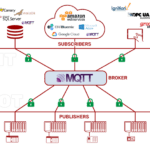 Reconsider the actuators, sensors, and other edge devices covered in Part 1 and Part 2 and Part 3 of this series. Such components are fundamental to edge computing. Supported by gateways and controllers with dedicated connectivity functions, these components use their logic resources to process data before sending it onward to controls, the cloud, or onsite servers and other IT infrastructures.
Reconsider the actuators, sensors, and other edge devices covered in Part 1 and Part 2 and Part 3 of this series. Such components are fundamental to edge computing. Supported by gateways and controllers with dedicated connectivity functions, these components use their logic resources to process data before sending it onward to controls, the cloud, or onsite servers and other IT infrastructures.
Also called fog computing, distributed intelligence and data processing out at a design’s most distal device levels (before data heads onward) have been available for some time. But devices with more computing power than in the past now allow more preprocessing and some of the predictive-maintenance functions that Phillips of Regal Beloit outlines for wireless connections. Another benefit to fog computing is a more holistic view of processes for iterative design optimization.
“We’ve actually pushed each technology generation to bring more logic, computing, and analytics to the device level,” says Rusk of Bosch Rexroth. He cites IndraDrive electric drives and MLC and MTX controllers as two examples for decentralized control — using what the manufacturer bills drive-integrated logic. These components support modular machine designs for scalability … and accept setup and operation via one software environment.
Other connected examples are specific to applications — such as handheld pneumatically and motor-driven tools (complete with integrated control logic) for fastening. Another assembly-specific example is the PRC7000 adaptive-resistance weld controller that manages weld growth in real time with onboard logic for repeatable spot quality … even on various combinations of sheet thicknesses and materials.


But even legacy systems without such IIoT tools and end effectors can benefit from new modes of connectivity. Here and in new installations, the role of gateways for edge computing is central — especially when smarter use of feedback for distributed control is advantageous … and disparate systems need unification. Examples from Weintek USA include cMT-series gateways and HMIs that accept setup via the manufacturer’s EasyBuilder Pro software — which in turn supports multiple programming languages and communication drivers. The gateways also run the supplier’s EasyAccess 2.0 software for remote access to automated equipment (via mobile devices) about machine health and other parameters. Such gateways execute many tasks typically associated with HMIs — such as running macros for control and data-transfer functions; concurrent networking of device arrays; handling and logging alarms; triggering data storage; and interfacing with cloud services.
For older brownfield equipment upgrades, IoT gateways and software can provide single-point data collection and preprocessing before data travels to a higher processing system, explains Rusk. His company introduced its first generation of IoT gateways several years ago and has continually advanced their designs.
“Our software called Active Cockpit Solution complements the gateways with edge-based visualization and shop-floor management for real-time decision making and collaboration. In addition, our platform-neutral WebConnector (based on the Java Runtime Environment) allows additional edge-based flexibility for the rapid exchange of data,” he adds.
Yet another example is Lenze’s X4 Remote solution — consisting of cloud gateways and a cloud-based range of easily configurable web services. It integrates smart-factory equipment into superimposed systems such as SCADA, manufacturing execution systems (MES), and enterprise resource planning (ERP) as well as the cloud. Besides the optimization of maintenance schedules previously mentioned, the solution also supports the exchange of information between suppliers and end users.
“IoT gateways are adaptable solutions that provide connectivity to nearly all devices and enterprise systems in the marketplace— and in some cases, to multiple PLCs at a time,” says Agnieszka Zupancic, product manager at Mitsubishi Electric Automation.
Additional applications include the management of consumable materials, contextualized visualization, and cellular connectivity to remote machines. OEMs in the packaging and printing industries benefit most from the insights gained through this access to production information, according to Zupancic — as they can use resulting data to develop features on their next-generation machines.


Some make a clear distinction between edge device and gateway functions. As mentioned, edge devices let end users receive and evaluate distilled data from the plant or other installation. According to sources at Festo, that’s in contrast with some IoT gateways that may only send data from the machine onward — without processing it. In addition, edge devices tend to support more modes of system monitoring as well as ways to backup data if a cloud link is temporarily unavailable.
In fact, Festo is currently developing an edge device that offers typical IoT functions — extracting data and then preprocessing and visualizing it on dashboards. Company representatives indicate that they may combine it with control tasks — to let design engineers closely couple it with their existing field devices.
Integrating gateway functions is another trend in increasingly capable controls such as industrial PCs (IPCs) and PACs. Says Prellwitz: “PC-based control is the foundation of our technologies, which means our portfolio provides the advanced connectivity needed for our IPCs to handle complex motion — and serve as gateways to the enterprise or cloud.” Many of the manufacturer’s controllers are certified for Microsoft Azure or Amazon Web Services — more on these shortly. The controllers also employ secure protocols such as MQ telemetry transport (MQTT), advanced message queuing protocol (AMQP), and OPC-UA. Such capabilities make machine data available for analytics, machine learning, and display on company or OEM dashboards anywhere in the world. ⚙️ Continue onward to Part 5 of this series: Motion control + MQTT, OPC-UA, and other protocols for cloud services






Leave a Reply
You must be logged in to post a comment.